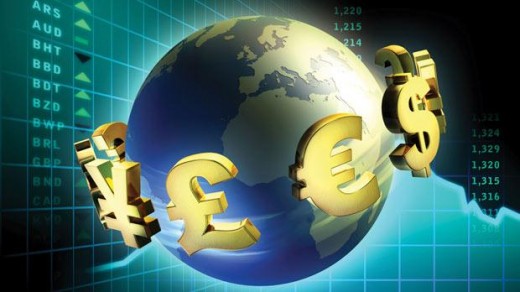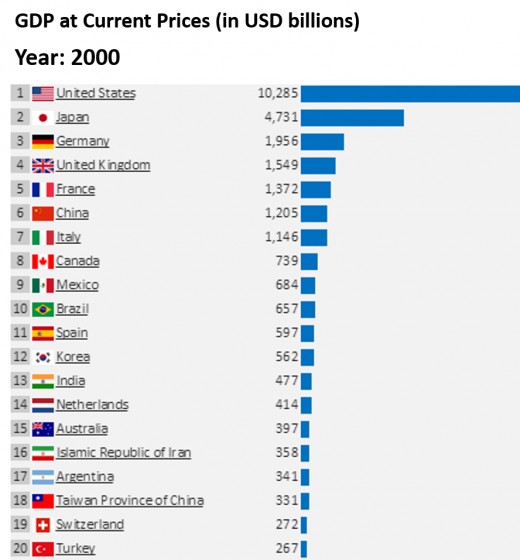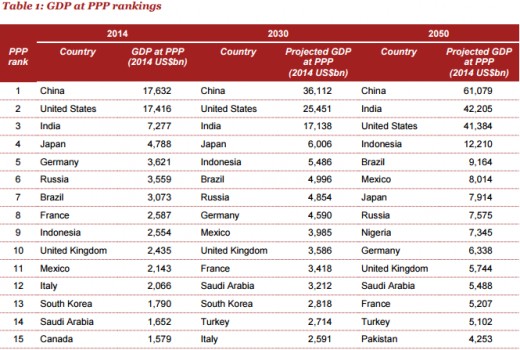Shift in the Balance of Economic Power

Growth Trends in the World Economy
The world economy is expected to grow at a little over 3% per annum between 2014 and 2050, which means that the global economy will nearly triple by 2050, according to a PwC report published in February 2015. The report goes onto saying that there could be a deceleration in the rate of growth after 2020. Economists are of the opinion that there would be a more sustainable long-term growth rate in most of the large economies.
Shift in Economic Power
Most leading economists and economic research organizations are in agreement regarding their prediction of a dramatic shift in the balance of economic power. The world is already witnessing a gradual shift in global economic power away from the advanced economies, and this trend is expected to continue over the next couple of decades.
The shift would be characterized by the largest emerging economies catching up and subsequently overtaking the leading advanced economies.
Global Economy: Projection of Long-term Growth
Status in 2015
According to rankings based on total GDP, measured at purchasing power parity (PPP), the world’s 10 largest economies as of October 2015 were:
- China
- United States
- India
- Japan
- Germany
- Russia
- Brazil
- Indonesia
- United Kingdom
- France
According to GDP measured at current prices, the rankings are:
- United States
- China
- Japan
- Germany
- United Kingdom
- France
- India
- Italy
- Brazil
- Canada
Source: Report published in October 2015 by the IMF (International Monetary Fund)


Growth by Industry
Apart from a shift in the balance of economic power among various countries of the world, there is expected to be a shift in the contributions made by different industries within a country. Taking the example of the US, growth in the travel and tourism industry is expected to exceed the average annual growth of the nation’s economy over the next decade.
While US GDP is forecasted to grow at a CAGR (compounded annual growth rate) of 2.3% in 2015-2025, the travel and tourism industry is projected to record a CAGR of 4.4% in real, inflation-adjusted terms. This compares with projected annual growth rates of 1.8% for retail and 2.85 for financial services, according to an article published by industry intelligence firm Skift.
US Economy: GDP Contribution by Industry - 2014
Industry
| % GDP
|
|---|---|
Retail
| 33.3
|
Financial Services
| 21.8
|
Banking
| 8.4
|
Travel & Tourism
| 8
|
Automotive Manufacturing
| 5.8
|
US Industry: Growth Rate 2015 to 2025
Industry
| CAGR
|
|---|---|
Travel & Tourism
| 4.4%
|
Automotive Manufacturing
| 4.0%
|
Banking
| 2.9%
|
Financial Services
| 2.8%
|
Retail
| 1.8%
|
Projections for 2016
Growth in advanced economies is projected to increase from 1.8% in 2014 to 2.4% in 2016. Growth in emerging economies is expected to increase from 4.6% in 2014 to 4.7% in 2016. Although the acceleration in growth would be lower in emerging economies, they would achieve significantly higher growth than achieved by the advanced economies.
Economic Growth Projections for 2016
Region
| 2013
| 2014
| 2015
| 2016
|
|---|---|---|---|---|
Advanced Economies
| 1.4
| 1.8
| 2.1
| 2.4
|
United States
| 2.2
| 2.4
| 2.5
| 3
|
Germany
| 0.2
| 1.6
| 1.6
| 1.7
|
France
| 0.7
| 0.2
| 1.2
| 1.5
|
Italy
| -1.7
| -0.4
| 0.7
| 1.2
|
Spain
| -1.2
| 1.4
| 3.1
| 2.5
|
Japan
| 1.6
| -0.1
| 0.8
| 1.2
|
United Kingdom
| 1.7
| 2.9
| 2.4
| 2.2
|
Canada
| 2
| 2.4
| 1.5
| 2.1
|
Emerging Economies
| 5
| 4.6
| 4.2
| 4.7
|
Russia
| 1.3
| 0.6
| -3.4
| 0.2
|
China
| 7.7
| 7.4
| 6.8
| 6.3
|
India
| 6.9
| 7.3
| 7.5
| 7.5
|
Brazil
| 2.7
| 0.1
| -1.5
| 0.7
|
Mexico
| 1.4
| 2.1
| 2.4
| 3
|
Middle East, North Africa, Afghanistan, and Pakistan
| 2.4
| 2.7
| 2.6
| 3.8
|
World Growth Based on Market Exchange Rates
| 2.5
| 2.7
| 2.6
| 3.2
|
Source: IMF, World Economic Outlook Update, July 2015
Projections till 2050
While China has already overtaken the US as the world’s largest economy in PPP terms, India is projected to overtake the US as the world’s second biggest economy by 2050. Moreover, the gap between these three largest economies (China, India and the US) and the rest of the world is expected to widen through the next few decades, according to a report published by PriceWaterhouseCoopers.
Despite this shift, the average per capita income, or GDP per capita, is expected to remain significantly higher in the advanced economies than in the emerging economies even in 2050.









